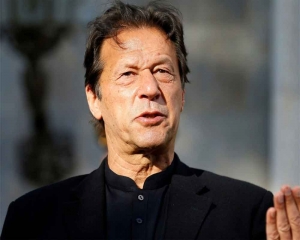Climate change consequences are too visible to ignore, while the response by the developed world is woefully short
Rather regrettably, despite the universal effort to achieve the 2030 Agenda, progress on the Sustainable Development Goal 13 (SDG-13), Climate Action, is severely lagging, signaling a red alert for humanity. Brutal heat waves have gripped the northern hemisphere. Several countries are sweltering under extreme temperatures.
Recently, thermostats in the United Kingdom rose above 40°C knocking off internet servers, suspending flights, and mass evacuations amid wildfires. Frequency of heatwaves in the States has tripled since the 1960s and the average heatwave season has increased by 45 days. India experienced its warmest March, with an average maximum temperature 1.86°C above the long-term average. Similarly, a new weather record was set in Pakistan in March 2022 with the highest maximum temperature recorded in Sindh at 45.5°C. In Tunisia, the temperature reached 48°C, breaking a 40-year record!
To address Climate Change, net carbon emissions must be lowered. Despite 197 countries having signed the 2016 Paris Agreement to mitigate, adapt, and finance climate change, the commitments have fallen short substantially. Rich countries undelivered their promise of providing $100 billion a year to less wealthy nations by 2020 to limit global warming to below 2°C, despite generating over 80 per cent of cumulative environmental spill over CO 2 emissions since 2010.
Unsustainability of their trade and consumption patterns is indeed a cause of concern. Though the rich nations are responsible for bulk emission of greenhouse gases in the past and therefore bear special responsibility towards developing countries, their progress on SDG 13 is inadequate. On the contrary, Lower and Lower Middle-Income Countries though performing better on SDG 13 are most vulnerable to Climate Change, as also least ready to adapt. India ranks 111 (with a poor score of 44) out of 182 countries in the ND-GAIN country index that captures country’s vulnerability to Climate Change and its readiness to improve resilience.
Thus, the journey from climate calamity to climate sustainability requires prioritizing the investment in Climate Action. Presently, this is a fraction of UN’s estimate of $3.5 trillion outlay annually to lower emissions by 43 per cent by 2030. By imposing price on carbon-based fuel, an effective instrument of environmental cost internalisation, governments can bridge gaps between private and social cost of fossil fuel consumption. So far, about 60 carbon tax and emissions trading programs have been introduced either at the regional, national, or subnational levels. The emissions price in the European Union has risen above €50 a ton. Canada too has announced its emissions price would rise to CAN$170 a ton by 2030.
However, as per IMF (2021), only about 20 per cent of global emissions are covered by carbon pricing with the global average price being only $3 a ton, much lower than the desired $75 a ton for keeping global warming below 2°C. In recent months, China and Germany launched major pricing initiatives, though India is yet to levy an explicit carbon tax.
Rationalising and phasing of government fossil fuel subsidies can limit carbon emissions by 2.6Gt by 2035, which is nearly half of the reduction needed to limit global warming to 2°C (IEA, 2020). In 2020, Iran was the largest single provider of fossil fuel subsidy payments, followed by China (oil subsidy at USD 21.7 billion) and India (oil subsidy at USD 17.1 billion). Though subsidies are provided to promote affordability among poorer, the impacts are often not optimal due to systemic leakages and non-effective targeting. Advancing climate action through public-private partnerships is also important for encouraging investments in large-scale climate-smart and resilient infrastructure. From execution of effective decarbonization pathways and commercial viability of carbon-capture technologies in critical sectors to green infrastructure, public-private collaborations can lead to effective outcomes.
Few successful illustrations of PPPs in climate action, are Uganda’s GET FiT program, and Morocco’s Ouarzazate solar project.
Addressing climate change also requires investments in green bonds, instruments that finance green projects achieving decent returns, while simultaneously hedging against climate change risks. This in turn disincentivizes high carbon-emitting projects. IFC green bond projects are expected to reduce GHG emissions by 23.9 million metric tons of CO 2 equivalent per year and produce 26,352,287 megawatt hours of renewable energy.
According to the Climate Bond Initiative (2020), new issues reached $257 billion in 2019, up from $142 billion in 2018. Despite the rise, immense untapped potential exists. Undoubtedly, prioritizing finance for Climate Action is crucial for human development..
(Prof. Simrit Kaur is Principal, Shri Ram College of Commerce. Kamaldeep Kaur Sarna is Assistant Professor, Shri Ram College of Commerce)

























